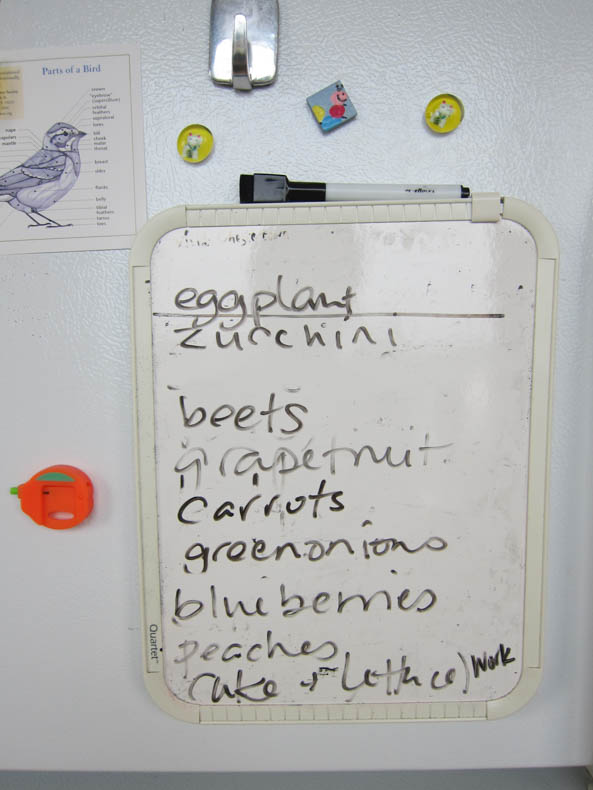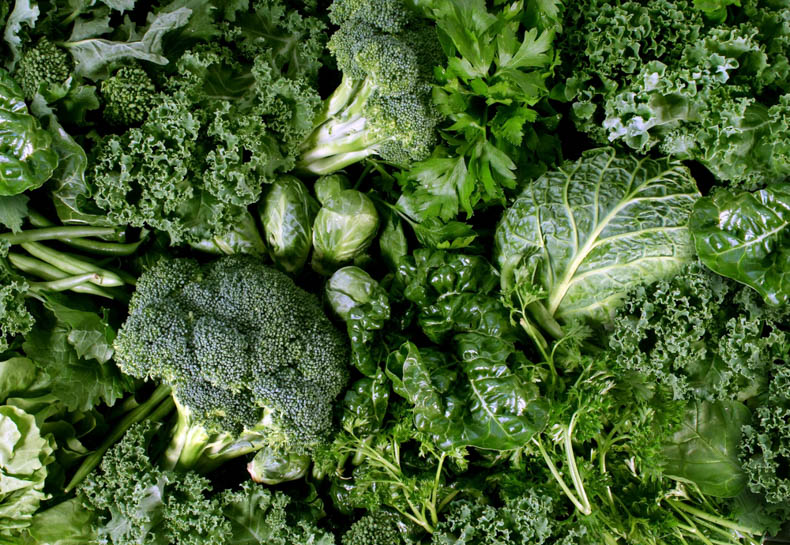I figured out how to eat vegetables.
Maybe everyone else figured this out a long time ago. But it took me until this year to figure out how to stuff myself with plant parts all summer long.
It’s a two-step process. One, a service. The second, a device on my refrigerator door.
First, the service. A few months back I signed up for a CSA. It’s also known as a farm share, and it stands for community-supported agriculture. I really am supporting my community; the farmer is a 20-something that I’ve known since he was a kid, running props backstage at a show I was in. I wrote my check for $470 and I figured, even if all the crops fail, at least I will have helped the kid try out farming his own piece of land. It may seem like a lot of money, but a friend agreed to split the share with me and it comes to about $10 a week for each of us for a good long stretch, from June to Thanksgiving. And, so far, the farm seems to be doing fine.
A CSA can be like a terrifying vegetable tsunami. A couple of times in past summers I’d picked up some friends’ share, from a different farm, when they were out of town. I was faced with a large quantity of greens with names like “mizuna” that I had never heard of and had no idea how to eat. I learned what a kohlrabi looks like and found out that mustard greens of all sorts can be tasty when stir-fried.
“Vegetable” is a funny category. Everyone knows a tomato is a fruit. They even look like fruit, all red and squashy. But they aren’t the only ones. Look inside a cucumber–those are seeds. Same with zucchini and all the other squash. Peppers. Eggplants. Green beans. Every one of these is the plant’s fruit, its reproductive organ. Somehow we lump them all in with the actual vegetative parts—the stems (celery, rhubarb), roots (carrots, turnips), leaves (kale, lettuce), and goofy starch-storage organs (potatoes).
I am a believer in the Michael Pollan theory of eating: Eat food. Not too much. Mostly plants. I love vegetables–I entirely prefer them to the foods we call fruits. But I find it difficult to eat a vegetable-based diet. Left to myself, I will stick with the ones I understand. Carrots are the best because they never go bad. Green beans are the best because they taste like heaven. Broccoli is quick to cook and reasonably tasty. Sweet potatoes are good, but generally cook for a long time, which means they require patience. These familiar vegetables get repetitive.
And there’s the problem of decision-making. When I go to the grocery store or even the farmer’s market, with its fresher and more interesting foods, I have to make choices. How many potatoes to get? Will I eat them? Are they worth that much? Does the other stall have them for cheaper? If I buy a winter squash, will I actually cook it or will it sit on the counter until I get tired of looking at it? How do you even cook an eggplant, anyway?
With the CSA, the choices evaporate. (Psychologists will tell you this is a good thing.) The vegetables appear, and all I have to do is decide what to do with them. The contents of the CSA bag become the elements of a constant, rolling puzzle: how do I convert these plants into food? And how do I do it before they rot?
Beet greens will go bad first. (I made this with beet greens yesterday and it was fantastic, plus it used up that dumb can of chickpeas.) Chard might go a bit longer. Zucchini will last, but not forever. (I eat this several times a week now and I’m never sorry.) The beets can sit around until I come up with an idea for them. (Ideas accepted in the comments.)
Now, for the second thing: The device on my refrigerator door. The entire vegetable problem-solving enterprise is tied together by this one tool.
 Vegetables used to go bad just because I would forget I had them. I came up with this plan a year or two ago. When a fruit or vegetable comes into the house I write it on the board, make notes on when I might eat it, and maybe add a star if it’s going to rot soon. When it’s gone, I wipe off its name. It works for things that came from the store or farmers market (grapefruit, peaches, blueberries, green onions) and for CSA contents, too (everything else).
Vegetables used to go bad just because I would forget I had them. I came up with this plan a year or two ago. When a fruit or vegetable comes into the house I write it on the board, make notes on when I might eat it, and maybe add a star if it’s going to rot soon. When it’s gone, I wipe off its name. It works for things that came from the store or farmers market (grapefruit, peaches, blueberries, green onions) and for CSA contents, too (everything else).
Ta-da. I did it. I’m eating tons of vegetables. You’re welcome, future self.
Photos: Vegetables: Shutterstock; Whiteboard: me.

We never ate beets until our daughter came back from Ukraine and started showing us how to make them. The simplest is just roasted beets: peel and cut into bite size peices, put in a large bowl and stir with some olive oil, finely chopped garlic, salt, and pepper, spread on a baking sheet and roast on the top rack of a 400-F oven for about an hour, until a skewer goes right through. They are heavenly this way as a side dish, or tossed in a salad the next day. You can add other veggies to the mix, like sweet potatoes, turnips, and parsnips, though the other veggies will be *very* soft when the beets and turnips are done.
Borscht could be a book; suffice it to say that it’s just chicken stew with veggies, and, in this case, shredded raw beets added near the end – they cook down to nothing and add color and an amazing sweet flavor. But there are a thousand recipes depending on which grandmother teaches you.
(When you are done shredding beets, btw, the kitchen looks like a serial killer has been there.)
It’s always important to remember the next morning that I had beets for dinner.
I used to steam beets, then saute halloumi, slice them both up, stack them, and sprinkle with sauteed walnuts until the store stopped carrying halloumi. Now I just think about it.
The second thing is a bit like a Planner Pad for eating, n’est-ce pas?
Ha! It totally is!
Key to root/gourd/large squash consumption, for me, is the knowledge that they can be cooked in the microwave SO much faster than in the oven. I’m talking 5-15 minutes vs. 45-75, though you do lose any of the lovely caramelization that comes from roasting. You can cut them up first (beets), or pierce and cook whole (potatoes, spaghetti squash, also beets, etc.). Helen, you obviously already know of my undying love for SmittenKitchen, but here’s one of my other go-to cooking blogs for seasonal produce inspiration, beet-ified for your viewing pleasure: http://www.staceysnacksonline.com/search?q=beets
My household’s usage of beets is often as simple as: cook them somehow, chop them up, eat them while exclaiming how much better REAL beets are than the canned ones we grew up with. I know a woman who makes a wonderfully simple dip by blending beets and goat cheese. We’ve made blended beet/cabbage soups; beets & their greens tossed with pasta (n.b. you end up with pink pasta); roasted chopped beets in a summer salad with nuts, chèvre, dark leafy greens of choice; cooked beets in a kale frittata.
Whiteboard as fridge PlannerPad: love it!
Also love beet salad. Toss beets in boiling water. Cook until a fork goes in easy. Dump in sink. Rub skin off under cold running water. Slice. Toss with walnut oil and some fruity vinegar, I like raspberry. Salt and pepper. if you really want to be fancy you can throw in crumbled blue cheese, toasted walnuts and shredded fresh mint. Et voila! Beet salad. Yum!
These aren’t terribly involved, and I love knowing I have a batch of them in the freezer for when I want a quick, delicious & healthy meal. I’ve used chick peas or black beans instead of cannellini, and just 4 cups of shredded root veggies, whatever was on sale or is sprouting in the kitchen.
http://themuffinmyth.com/2015/02/beautiful-beet-burgers-vegan/